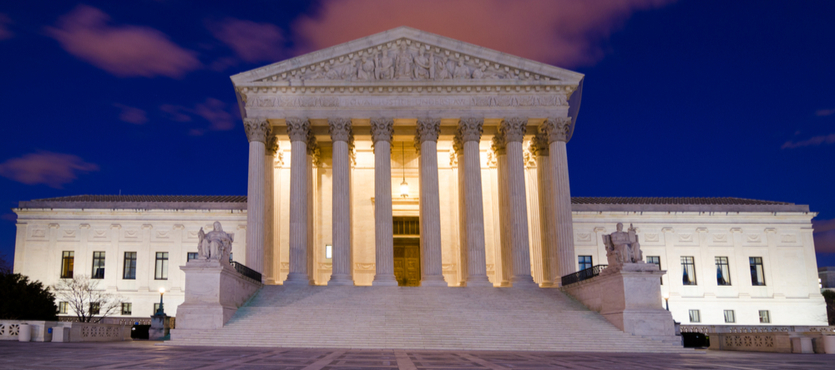The U.S. Supreme Court refused to hear the final appeal in a veteran’s lawsuit against KBR, putting an end to a court fight that had lasted the better part of a decade. But former Iraq War contractors still have legal options available when it comes to compensation for their injuries.
Under direction from military commanders, KBR contractors constructed a number of large burn pits in Iraq. One of the largest and most notorious ones was at Joint Base Balad (a/k/a Camp Anaconda). Hundreds of sick veterans joined in the lawsuit, but a district judge dismissed the action, and the U.S. Court of Appeals for the Fourth Circuit upheld that decision. In district court, KBR lawyers argued that the contractor was just following DoD orders and that judges could not second-guess decisions like these made during wartime. The Supreme Court affirmed this technicality without comment.
Rosie Torres, the widow of Army Reservist and lead plaintiff Leroy Torres, said that “America has turned its back on its war heroes.” Paul Rieckhoff of Iraq and Afghanistan Veterans of America added that “Burn pits are our generations’ Agent Orange.”
Burn Pits and Agent Orange
Paul Rieckhoff compared burn pit exposure in Iraq with Agent Orange exposure in Vietnam, and the comparison is probably an apt one. Agent Orange is a toxic defoliant which the Air Force sprayed on the jungles of Southeast Asia. The intent was to kill the foliage and deprive the enemy of cover. That plan looked pretty good on paper, but never worked too well in practice.
Additionally, Agent Orange contained traces of dioxin, a by-product of the chemical manufacturing process. During the 1960s, this process was not as tightly-controlled as it is today, so such byproducts were common. Dioxin alters cell genetics, causing them to reproduce much more rapidly than they should. The resulting cell clusters usually form tumors, and some of these tumors are malignant.
Needless to say, Dow Chemical did not intentionally lace Agent Orange with dioxin. But nevertheless, the Veterans Administration eventually began paying compensation for some veterans. For decades, the VA denied that there was any link between Agent Orange and cancer. Even today, Vietnam veterans who served offshore on naval vessels are still fighting for Agent Orange compensation.
2,3,7,8-Tetrachlorodibenzodioxin (TCDD) is the primary dioxin in Agent Orange. Scientists have also detected TCDD in burn pit smoke.
When KBR contractors dug huge open-air pits, filled them with garbage, and set them ablaze, no one thought about the toxic chemicals that were in the billowing smoke. The refuse included medical waste, vehicle parts, ammunition, Styrofoam cups, and other materials which are illegal to burn. So, it is not surprising that a number of veterans got sick. In fact, as outlined below, many became seriously ill.
The effect is worse among KBR and other contractors than regular servicemembers. These contractors spent the most time closest to the pits.
Almost immediately after veterans began complaining of respiratory illnesses, the VA said the condition was environmental, due to dust and particulate matter in the desert. That excuse belies the fact that many people developed breathing problems while stationed in mountainous areas. Moreover, there is a presumption in many states that when firefighters develop certain kinds of illnesses, toxic smoke caused them. This same presumption can help a DBA attorney obtain compensation for your burn pit illnesses.
Burn Pit Injuries
Toxic burn pit smoke may affect both the lungs and other cells in the body, most notably in the liver and brain. The smoke affects the lungs in much the same way that other toxic particles, like asbestos, affect the lungs. Many parts of this organ are extremely sensitive. Almost any foreign substance, especially a toxic one, causes massive swelling and other problems.
Doctors often do not connect symptoms like shortness of breath and coughing with serious lung disease, especially if the patient is a relatively young and healthy non-smoker. As a result, conditions like constrictive bronchiolitis simply get worse. Eventually, the victim has trouble breathing even while resting. At that point, a radical lung transplant is basically the only treatment option.
Digestive cancers, particularly pancreatic cancer, are quite common among burn pit exposure victims. The body tries to get rid of the toxic smoke any way it can, so it often accumulates in the pancreas. This form of cancer is especially aggressive. If victims do not get treatment straight away, it often spreads to other parts of the body.
Injury Compensation Available
The Defense Base Act provides injured contractors with the financial resources they need to recover from things like burn pit injuries. DBA insurance pays for all reasonably necessary medical expenses, usually from the first day of emergency care to the last day of physical therapy.
Additionally, DBA benefits also include money for lost wages. This money gives families the income they need to pay everyday expenses while the victim recovers. Most victims receive two thirds of their average weekly wage for the duration of their temporary disabilities.
Usually, these claims settle out of court. A few weeks after victims file their claims, there is a settlement conference between the victim and insurance company. A DBA officer, who has reviewed the medical and legal records, presides over this hearing and tries to engineer a settlement. This conference is usually unsuccessful, however. An attorney has very little latitude at this stage.
That dynamic changes significantly at a subsequent administrative hearing. This hearing is a lot like a trial without a jury. An attorney can introduce favorable evidence, challenge unfavorable evidence, and make legal arguments.
The DBA insurance company knows that the victim’s attorney basically has the advantage at an administrative hearing. So, many cases settle in between the conference and the hearing. If that is the case, benefits are usually retroactive to the date of injury.
Contact Barnett, Lerner, Karsen, Frankel & Castro, P.A. to receive both assertive legal representation and solid legal advice.

